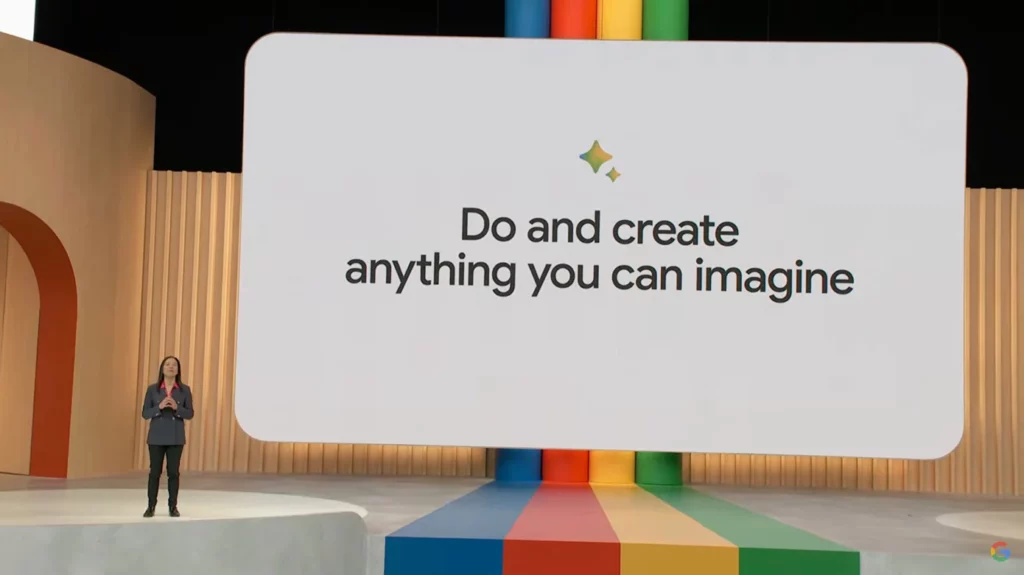Google is all-in on AI, recently introducing a bunch of new developments.
In case you missed Google’s I/O event, the company showcased a whole bunch of exciting new features, updates, and products it’s rolling out. Of course, the buzzword of the event was “AI” (which was mentioned 143 times during the presentation).
As we know, when Google makes changes and updates, this can affect many different areas of your business’s marketing plan. So, staying up-to-date with the tech giant is always a good idea.
To help you understand everything new that Google is introducing, here are some of the main highlights and new updates from the I/O event.
- Magic Editor and Magic Compose
- Google Maps
- Bard
- Workspace
- PaLM 2
- MusicLM
- Search
- Codey
- Sidekick
- Imagen in Vertex
- Universal Translator
- Project Tailwind
- Google Play Store

Image Credits: Google
Magic Editor and Magic Compose
Google has introduced an impressive enhancement to its photo editing capabilities with the AI-powered Magic Editor feature.
Now, users can make more intricate edits to specific elements of their photos, like the foreground or background. This advanced tool can fill in missing parts of the photo and even reposition the subject to achieve a better-framed shot. Be sure to explore this exciting feature.
There is also a new addition called Magic Compose. This feature can rewrite text in various styles within messages and conversations. For instance, the feature can make the message sound more positive or professional.
Google Maps
Google Maps has introduced an exciting addition called “Immersive View for Routes” in specific urban areas.
This new feature consolidates a wide range of important information for users, like traffic simulations, bike lane specifics, intricate intersections, parking availability, and more. Basically, this means you get a much better picture of what a route with Google Maps will be like.
Bard
Exciting news: Google is taking a significant step by eliminating the waitlist for Bard, making it accessible in English across more than 180 countries and territories.
What’s more, Google is expanding Bard’s language support to include Japanese and Korean, with plans to accommodate 40 languages in the near future. Bard can also present images in its responses, adding a new dimension to its functionality.
To take things further, Google has joined forces with Adobe to incorporate art generation capabilities into Bard. Bard users will be empowered to generate images through Firefly and customize them using Express. Within Bard, users can choose from various templates, fonts, stock images, and other assets available in the Express library.
Workspace
Google is infusing its Workspace suite with AI capabilities to enhance its intelligence.
Sheets will now include automatic table generation (excluding formulas), while Slides and Meet will gain the ability to create images.
The automatic table feature in Sheets is relatively simple, but it’s possible that more advancements are on the horizon for utilizing AI in formula creation.
As for Slides and Meet, users can now simply type in the desired visualization, and the AI will generate the corresponding image. Notably, Google Meet users will have the option to use custom backgrounds.
PaLM 2
PaLM 2 is Google’s latest large language model (LLM).
PaLM 2 will drive the enhanced Bard chat tool, which competes with OpenAI’s ChatGPT. It will also serve as the foundational model for numerous new AI features just introduced by the company. PaLM 2 also offers enhanced support for code writing and debugging.
MusicLM
Introducing MusicLM, an innovative AI tool developed by Google that transforms text into music.
You can effortlessly generate the exact type of music you want by typing a relevant request. This tool has some fascinating possibilities.
Search
Google Search has implemented two new features to improve content understanding and provide context for images displayed in search results.
These advancements include an “About This Image” feature that offers additional information and the introduction of markup in image files to label them as “AI-generated.” While these features enhance transparency regarding image credibility and AI generation, they are not a definitive solution to the broader issue of AI image misinformation.
Google is also experimenting with an AI-powered conversational mode. This mode presents users with suggested next steps and provides an AI-generated snapshot of key information, accompanied by links for further exploration.
Tapping on a suggested next step opens a new conversational mode, allowing users to inquire more about the topic while maintaining contextual continuity throughout their questions.
Google has also introduced a new “Perspectives” filter, soon to be available at the top of select Search results. This filter aims to present insights from others’ experiences, including posts from discussion boards, Q&A sites, social media platforms, and videos. This feature should make locating relevant links from platforms like Reddit or YouTube easier.
Codey
Codey is Google’s latest code completion and code generation tool. As part of a suite of AI-focused coding tools just launched, Codey is Google’s response to GitHub’s Copilot—a chat tool primarily used for coding inquiries.
Codey has gone through specialized training to excel in handling coding prompts and addressing queries related to Google Cloud services.
Sidekick
Introducing Sidekick, a newly revealed tool. It’s been described as a resource intended to enhance prompts and potentially challenge human input in the generative AI process.
The Sidekick panel resides in a dedicated side panel within Google Docs. It continuously reads and analyzes your entire document while you write, offering contextual suggestions that directly relate to your written content.
Imagen in Vertex
Google unveiled a range of new AI models that will be integrated into Vertex AI, its comprehensive managed AI service.
Among these models is Imagen, a text-to-image model that was initially showcased through Google’s AI Test Kitchen app in November last year. The tool has the ability to generate and modify images, along with the capability to provide captions for existing images.
Universal Translator
In the recent I/O event, Google showcased a groundbreaking translation service currently undergoing testing. Known as the “Universal Translator,” it can convert videos into a different language while synchronizing the speaker’s lip movements with words they never actually spoke.
It’s an awesome demonstration of the recent AI advancements, yet it also highlights the need to address the significant risks associated with such technology right from the outset.
The “experimental” service takes an input video, like an online course lecture recorded in English, transcribes the speech, translates it, and reproduces the speech in the target language. This is done all while matching the original style and tone. The tool finally modifies the video to ensure better lip synchronization with the newly generated audio.
Stay tuned for further details on this remarkable innovation.
Project Tailwind
Despite its name resembling a covert government operation, Project Tailwind is actually an AI-driven notebook tool developed by Google.
Its main goal is to organize and summarize a user’s free-form notes automatically. This tool can be accessed through Labs, Google’s platform for experimental products.
Users select files from Google Drive, and Project Tailwind generates a private AI model specialized in that specific information. It also provides a personalized interface to assist users in navigating through their notes and documents.
Google Play Store
Google’s Play Store has also been updated with various new possibilities, thanks to all these AI developments.
Here are some of the key features and enhancements:
- Simplified Play Store listings: Developers can now utilize Google’s PaLM 2 model to generate a draft of their Play Store listing based on a few prompts, such as target audience and key themes. They have the freedom to customize the generated draft to their liking.
- App reviews summary: Currently available only in English and limited to positive reviews, developers can access a summary of app reviews to gain insights and feedback.
- Store Listing Groups: In addition to the custom store listings introduced by Google last year, developers can create Store Listing Groups that enable customization of specific elements beyond the base listing.
- Promotional Content: The Play Store introduces new placements for in-app events, including Play Store notifications, the For You section on the Apps and Games tabs, Play Store search results, app-specific search results, and the Search screen itself. These placements provide greater visibility for promotional content, even before users initiate a search.
Stay tuned for more updates and explore these exciting features to enhance your app’s performance on the Play Store.
Wrap-Up
These are some of the most exciting new developments out of Google. Be sure to keep an eye on them, as they could help you grow your business a lot more efficiently.
We think that embracing the possibilities of AI is something every business should be doing. This is why Wishpond has joined the list of AI innovators by introducing an AI-powered website builder that can generate an entire website for you with just a few simple prompts. Check it out if you’re interested in using AI to run your business more efficiently.

